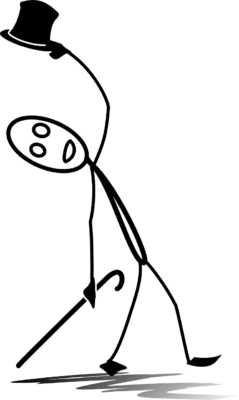
E. M. Forster, in his 1927 Aspects of the Novel, applied the terms “flat” and “round” to describe fictional characters (pp. 103-166). Those true to life he considered to be “round,” while “flat” characters served only one purpose in the story.
Authors create flat characters to represent a specific idea or quality.
Flat characters are “immediately recognizable and can usually be represented by a single sentence,” or characteristic. A flat character wants one thing. For example, Miss Havisham from Charles Dickens’s novel Great Expectations, is a flat character who seeks only revenge for being abandoned on her wedding day.
Flat characters:
- lack depth or development.
- support the main character, or other characters. Many stories and novels in fact feature flat characters as main characters, Sherlock Holmes and Doctor Watson for example, as well as the characters in various stories such as the “Twilight” series.
- maintain the characteristics or familiar traits of a stereotype, e.g., Miss Havisham as the jilted bride.
- maintain one perspective or viewpoint.
- help create atmosphere, mood, or comedy.
- are vivid but simple.
- predictable in terms of their behavior.
- are easily recognizable by readers and remembered for these very characteristics.
Besides Miss Havisham, other well-known examples of flat characters include Sykes from Oliver Twist, Benvolio in “Romeo and Juliet,” and sitcom characters such as the clueless Dad or Mom in “The Goldbergs” or Newman in “Seinfeld.”
When a flat character takes on multiple aspects and a realistic character defects, the flat persona curves towards the rounded character.
The term “round” refers to characters sufficiently complex “to be able to surprise the reader without losing credibility,” as William Harmon and Hugh Holman state in their classic work, A Handbook to Literature. As readers, we invest more emotion in round characters and may well feel disappointed when we no longer have them in our lives, once we finish reading their stories.

Round characters:
- appear human, with multiple aspects to their personalities.
- let us know what they are thinking.
- can surprise us.
- are convincing and rich in character with flaws and qualities.
- have potential to change and develop throughout the story.
- desire something.
- experience conflict and therefore character development.
- are either likable or despicable.
Round characters invite us to see the world as they see it. Think of Hamlet, Huck Finn, Anna Karenina, Mrs. Dalloway, Achilles, Captain Ahab, Lady Macbeth – all serve as examples of rounded characters.
Forster summed up the nature of “round” characters by saying, “As for the round characters proper, they have already been defined by implication and no more need be said.” (p. 117)
I think I’ll go lie “flat” for awhile now.
See you next time.
Kaye
For Further Reading:
Burroway, Janet, et al. Writing Fiction: A Guide to Narrative Craft. Pearson, various editions and printings.
Stevick, Philip. The Theory of the Novel. Free Press, 1974.
Stone, Sarah and Ron Nyren. Deepening Fiction: A Practical Guide for Intermediate and Advanced Writers. Pearson, 2004.

Joan H. Carter
Thank you, Kaye, for putting the frequent admonition, “Develop your characters,” into perspective. The author needs to focus on those important to the story and not distract the reader’s attention by developing every one.
Marie Q Rogers
I never thought of Holmes and Watson as flat characters, but upon reflection, they are. So, even flat characters can intrigue and entertain us. I suppose if we are looking for emotional involvement or personal growth in our fiction reading, we look to round characters to supply those aspects.